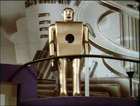
The NREC made headlines a few weeks ago, when President Barack Obama visited and launched the Advanced Manufacturing Partnership. Among other things, it calls for $70 million in federal funds to support research into robots that “will work closely with human operators, allowing new ability for factory workers . . .to carry out key, hard-to-do tasks.”
While I was walking past an impressive array of state-of-the-art robotic technology, I couldn’t help but think aboutElektro. Never heard of him?
“Elektro the Moto-Man” was the star of the Westinghouse Electric Corp. pavilion at the 1939 New York World’s Fair. Today, he’s in permanent retirement at the Mansfield Memorial Museum in Mansfield, OH. A replica is on display at the Heinz History Center in downtown Pittsburgh.
Compared to the whiz-bang technology currently being developed by NREC engineers,Elektrois quite primitive. But, he’s a bona-fide robotic pioneer. The 7-foot tall, 160-pound humanoid was developed in the mid-1930s by engineers at the Westinghouse Appliance Div. plant in Mansfield, OH (the facility closed in 1990).
Elektrowas made from an assortment of electromechanical parts and components used in Westinghouse appliances. For instance, cords used to assemble coffee makers and irons were used for wiring. Wheels used on the bottom ofElektro’s feet were borrowed from vacuum cleaners.
The robot’s body, arms and legs were fabricated from aluminum. Inside, a wide variety of electric motors, gears, cams, cables, chains, sprockets, vacuum tubes, speakers and photo electric cells allowed the humanoid to operate.
Elektrowalked after receiving voice commands. He also could count using his fingers, sing a song and smoke cigarettes. In addition,Elektrohad a dog namedSparko, who was patterned after a Scotty.
After the New York World’s Fair closed,ElektroandSparkotoured the United States for many years, stopping at appliance retailers and department stores to tout various Westinghouse products. But,Elektro was disassembled in 1960, packed away into crates and forgotten about until 2004.
Meanwhile, Westinghouse donated $5 million to CMU in 1979 to create the Robotics Institute, which today oversees activities at the NREC. Westinghouse invested in robotics research again in the 1970s, but after acquiring industry pioneer Unimation in 1983, it dropped out of the industry in the late 1980s.

Recent Comments
Helpful for Trainees
Cable Assembly Manufacturers
Huawei for manufacturing?
should have a scanner and then 3D print the repair
IPC-A-610 and IPC-j-std-001